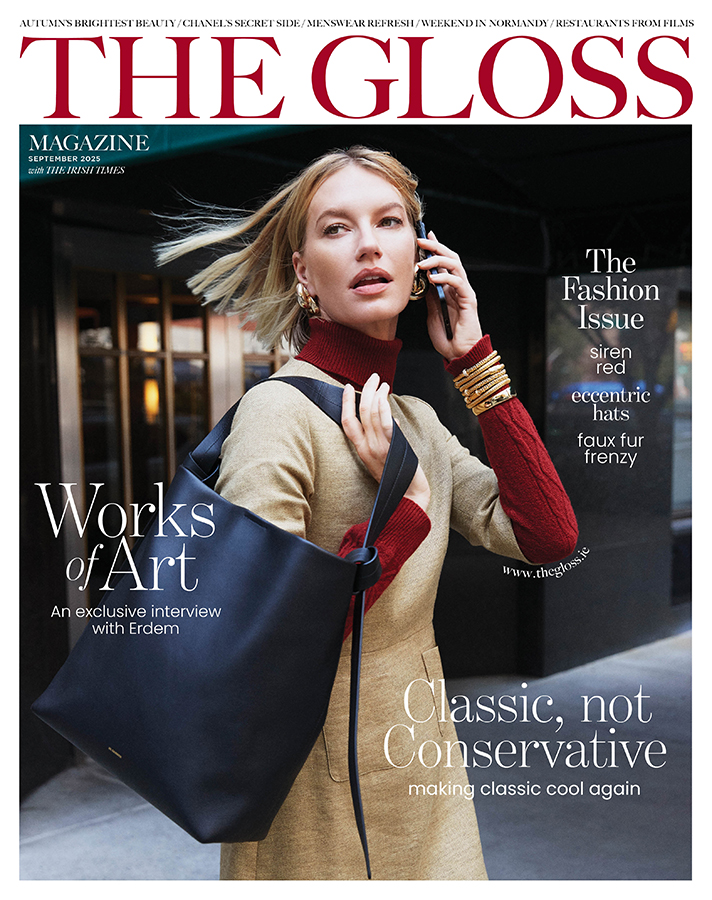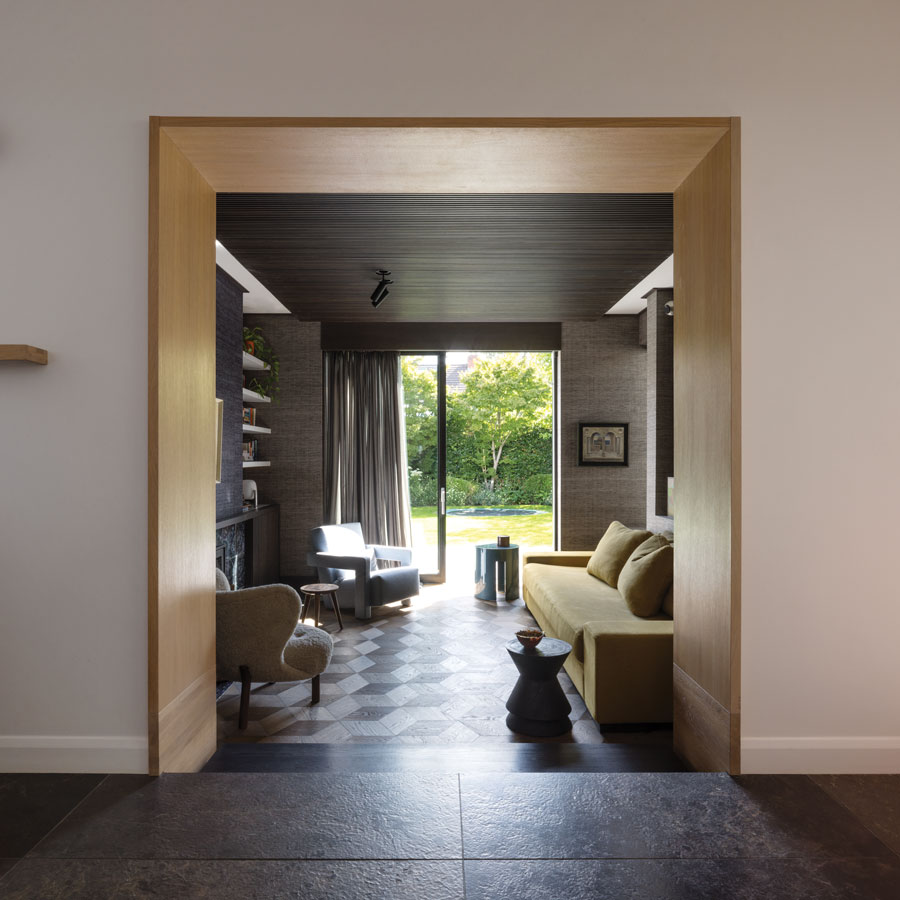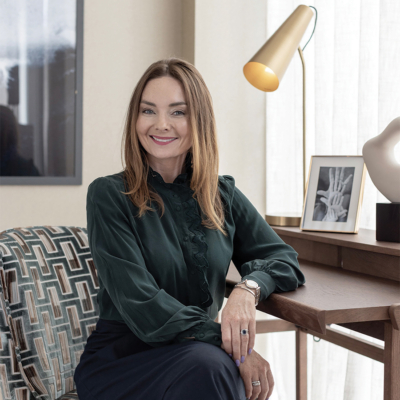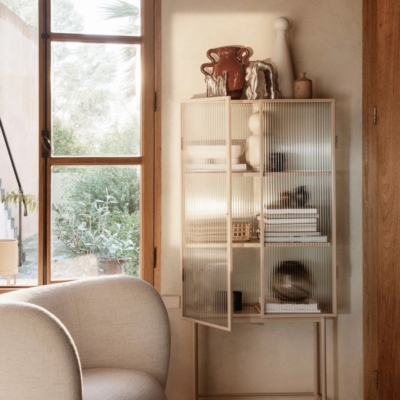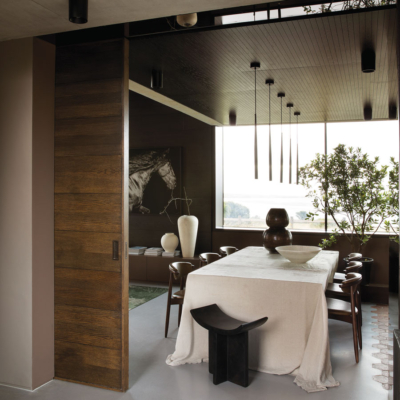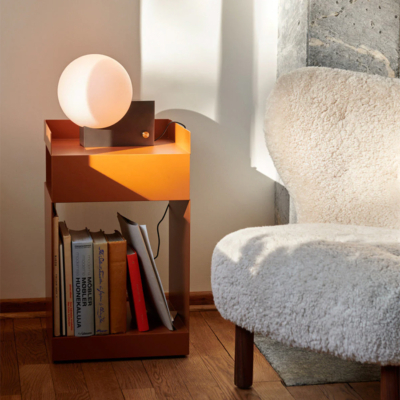The design intent of this refurbishment was to capture the mid-century mood of the client’s and architect’s former family home
Over the course of many conversations between architect Maria MacVeigh and her sister and brother-in-law, their proposal for a modest kitchen update eventually evolved to become a plan for a full extension and refurbishment. Such are the powers of persuasion of a trusted family member, who is also a visionary designer! Built in the 1990s on a corner site in a 1950s housing estate in Dublin 6, the existing house lacked the character of its neighbours but benefited from the corner site location and extensive garden.
As project discussions progressed, the design intent to capture some of the essence of their own family home where the sisters grew up emerged. Memories of its white walls, joinery detailing, beautiful paintings, mid-century furniture and a plan that followed the sun to perfection, resonated. Both architect and client agreed that the project would have midcentury modern as a reference point, not only as a nod to their upbringing but to reflect the origin of the neighbouring 1950s houses that surrounded this relative newcomer on the block.

Light streams through a simple venetian blind.

Porticoes or reveals frame the entrance from the dining and kitchen space to the garden-level living space. The step down from the stone floor to the timber floor is emphasised in solid stained oak. The base of the porticoes are solid timber, transitioning to veneer. The solid dark and light oak timber floor, by Amsterdam Flooring, is laid in a diamond pattern and heavily brushed to create a textured look. The sliding doors to the garden are black stained Accoya timber with timber reveals, with fine cashmere drapes from Minima, that give a warmer look. The sofa is by Orior.
The front of the house faces west and the wide rear of the house faces east. In the very early 2000s, a two-storey extension to the rear was added by the previous owners so the biggest challenge was what to remove, what to keep and where to extend. It was apparent to MacVeigh that dropping the floor levels would be key to the success of this extension and refurbishment; a greater floor-to-ceiling height would enhance the substantial alterations to the ground floor necessary to make the living spaces fit and flow well.

The material contrasts are subtle but effective: the television on the navy tweed wall covering by Phillip Jeffries is illuminated when on, but disappears into the dark wall when off – genius! The fireplace terracotta tile surround is faience, a tin-glazed finish.

Front and back gardens were designed by Maria MacVeigh with landscape designer Bernard Hickie.
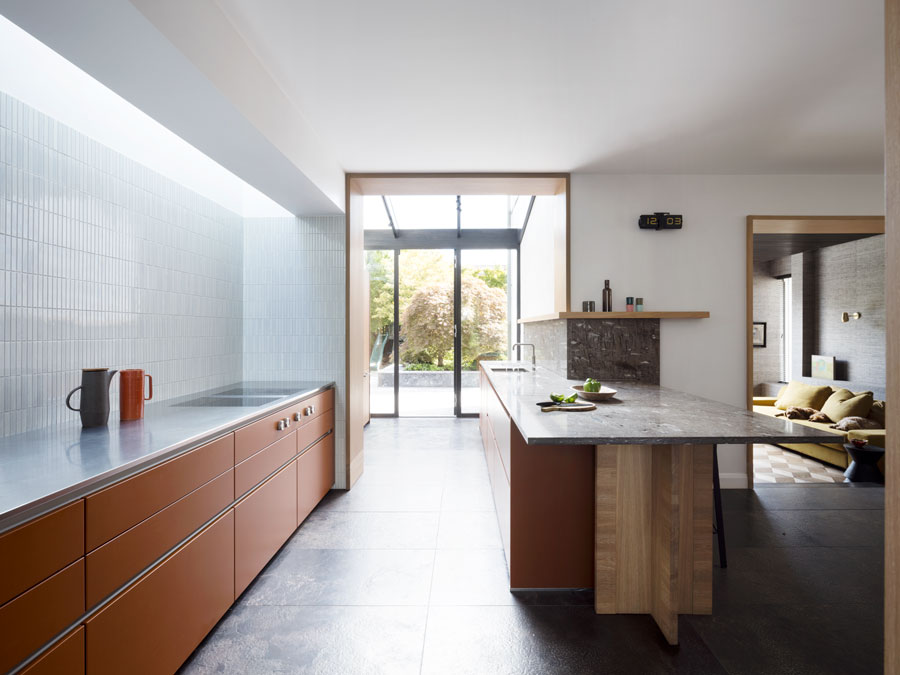
A view of the open-plan living space.
The plan eventually evolved to a cruciform, and as the house had a couple of steps up at the entrance and four steps down to the rear, it was decided to drop the floor level to bring the garden within two steps of the living space. Dropping the original extension to the garden level, the plan was to extend to the side with a generous side entrance and bike room and to push out each end of the original living space to bookend the new kitchen dining space with roof lights that capture south, east and west light.
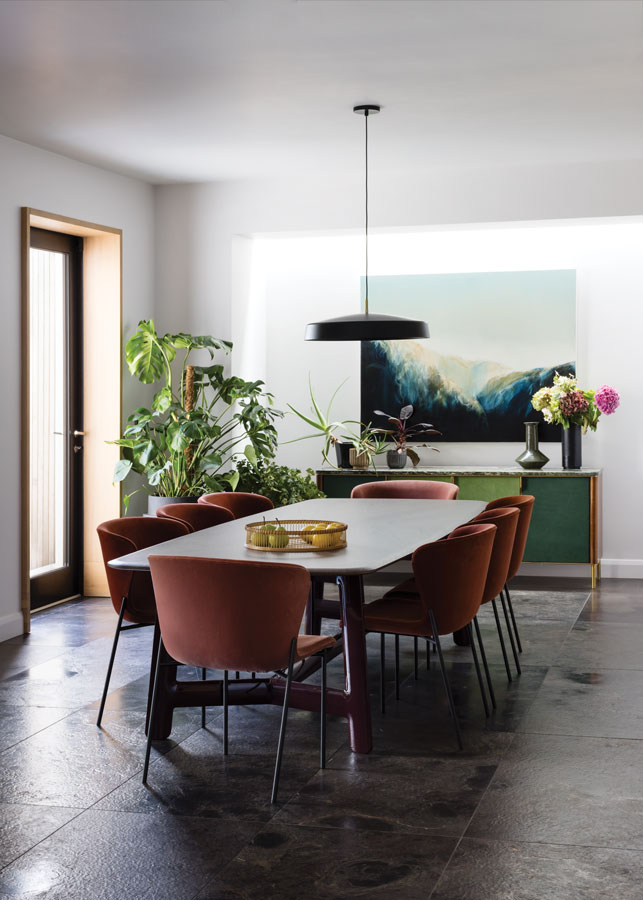
In the dining room, a B&B Italia wenge-topped table with lacquered legs, and dining chairs upholstered in burnt orange, all from Minima. The pendant light is by Lambert et Fils.
The original extension became the garden-level living space with two gentle steps separating it and giving it a sense of enclosure, while still maintaining the connection with the kitchen and dining space. The kitchen extension is a galley with a glass roof which closes the space between the brick and lime-washed extension and the original extension to the rear. “The kitchen extension is a direct reference to a Victorian house our great-aunts lived in close by,” says MacVeigh. “The house they lived in had a galley kitchen with a polycarbonate roof.”
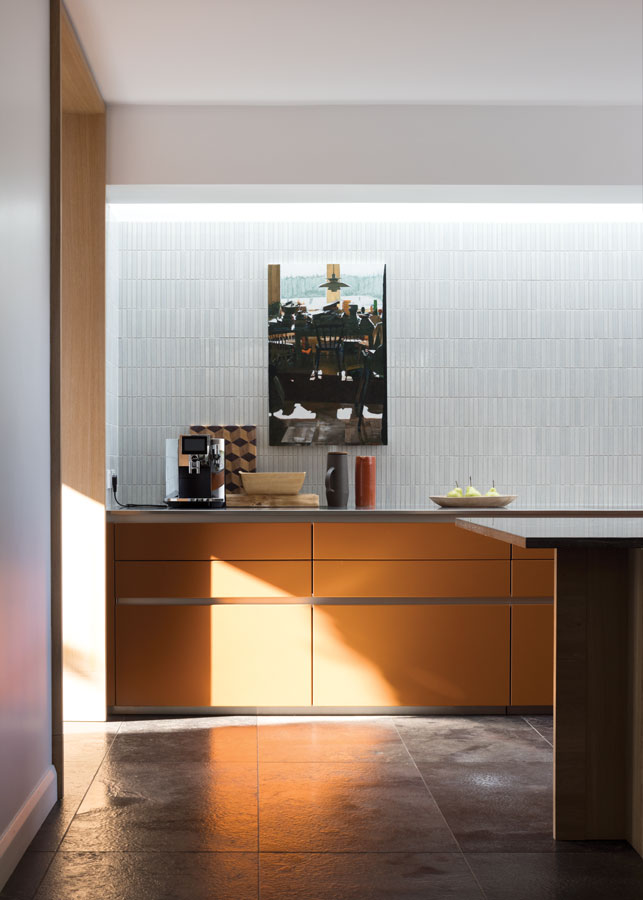
The kitchen by Realm, with deep orange cabinetry, “kit kat” tiles and mix of stainless steel and timber finishes, offsets the stone floor by Design by Paddy.
MacVeigh used mid-century modern design as a reference point but not a theme. “My clients wanted colour but also tranquillity. The toneddown version of mid-century was captured in the textiles we used in the living room, the textured wall coverings, muted earthy colours, the faience terracotta tile around the fireplace and the dark timber joinery and dropped ceiling.”

The kitchen island extends into the galley kitchen extension with its treated larch veneer cabinetry and glass roof.
Architect and clients were very much in agreement that the front and back gardens were a fundamental part of developing and upgrading the property. “Thankfully my clients had the vision to do that, the garden really makes the scheme. If you open up a house to light and the exterior, the exterior becomes a fundamental part of the living space, so a realistic budget for achieving that should be a consideration in any project,” says MacVeigh, who worked with Bernard Hickie on the design and planting. “My brother-in-law has a great love of trees and the row of amelanchiers to the front of the house which have just turned copper bring great joy to the family and everyone passing by the once-dreary corner site.”

The oak veneer panelling behind the bed also houses the window. The wall covering is by Phillip Jeffries and the silk carpet is by Jacaranda Carpets and Rugs. The pendant is by Bert Frank. The basket-weave throw is from Stable of Ireland. The bedroom furniture is by Abington.
Because of the new side entrance, the front door becomes somewhat obsolete, allowing a new stairs occupy more hall space to accommodate the extra steps from dropping the floor. As with all the new design elements, the stairs presented an opportunity for an exercise in detailing. “Rationalising was important so as to not saturate the project with design gestures,” says MacVeigh. Mid-century design references are everywhere – from the materiality in the large oak reveals or porticoes that frame all the openings of the ground floor, the doors with a criss-cross design that references basket weaving and the craft of design encapsulated in midcentury design, to the 1950s style furniture and fittings and the shapes and textures of the period that are faithfully observed. www.mariamacveigh.com
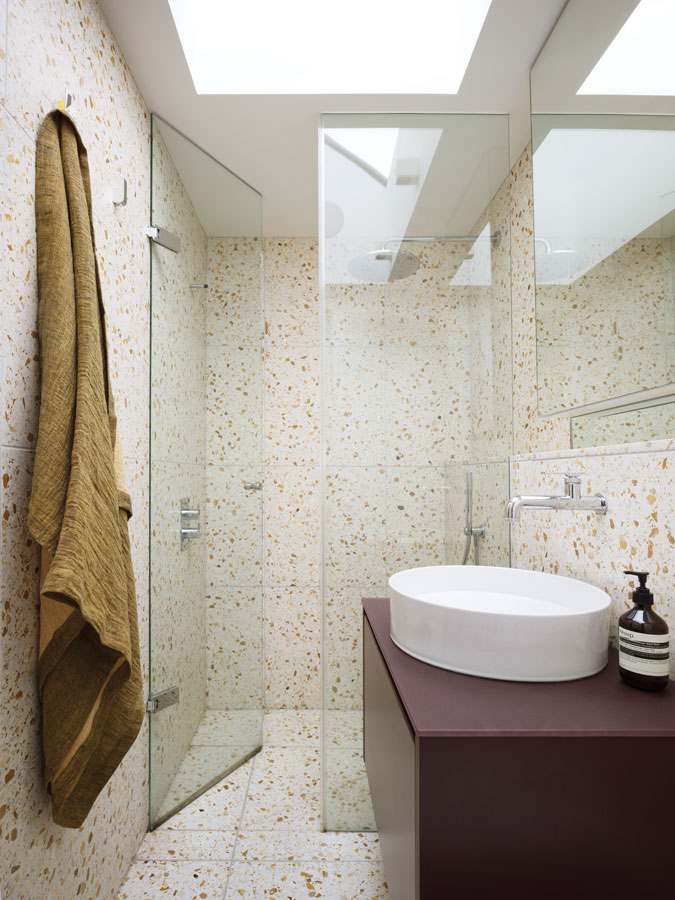
The shower room, with terrazzo tiles from Regan Tile Design.
Photography by Aisling McCoy. www.aislingmccoy.com
SEE MORE: A Restorative Extension Leaves This Victorian Redbrick Looking Seriously Sophisticated

Design Talk: Maria MacVeigh
Anantara The Marker Dublin
Thursday May 22 | 12pm-1.30pm
In conversation with architect and broadcaster Amanda Bone, Maria will discuss how her two professions give her a unique perspective.
Ticket: €35 | Students: €20
See the full 2025 DWD programme at www.designweekdublin.com




